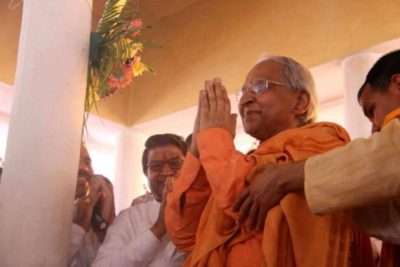
Message for International Day of Yoga from Swami Veda Bharati – June 21, 2015
Message for International Day of Yoga
from Swami Veda Bharati
June 21, 2015
This is to the beloved manifestations of Divine Atman in Yoga,
My dear self,
I pay homage to the founders, the sages, the rishis of the Guru lineage by whose compassion, intuition and insight this eternal knowledge has come to bless and grant us beneficences at this time of our ongoing history of spiritual development in humanity.
One example, the most contemporary example…
Soon after Mr. Narendra Modi was elected Prime Minister of India he addressed the United Nations and proposed that there should be an international yoga day. Unprecedentedly 177 nations favoured the proposal. It is thus that 21st June has been declared as the international yoga day every year.
On such a day, all those who follow the inner spiritual core of yoga in their quest, in whichever branch of spiritual yoga, they need to get together to share their inner experiences, contemplate on their advancement in the quest, and be in a mode of deep inner silence.
On this day, let all those who adhere to the ancient systems of yoga as taught by the rishis gather and meditate together. Meditate with body, mind and spirit.
What can yoga grant to us? Here is a recent contemporary example.
Commonly when politicians are fighting elections, on the day the results are to be announced, they are all in a state of extreme anxiety, hooked to the TV, phoning everywhere, and so on.
The present Prime Minister of India who is an initiate of a swami was expecting the announcement of the election results on 16th May 2014. That day he did not turn on the TV until after 12 noon; he only sat in solitude and in meditation. This is the way of a meditator. And this is what yoga grants to us. To be most successful and remain silent.
When he went to visit the USA, it was in the middle of sacred fasting days. He had a hectic program. He met President Obama several times, gave impressive public addresses including the one in Madison Square Garden, all while continuing his fast. His unbound energy inspired everyone; it made everyone wonder as to the source of that energy and of his magnetism. The source is his yoga and meditation.
This is just one contemporary example. One illustration of what yoga grants while we live in the world. This is just one illustration.
Do not say ‘I cannot meditate because I am busy pursuing worldly success.’ Pursue and succeed but be not stressed by that pursuit.
What is this yoga? What is it? What are the signs of one practicing yoga?
On the very first sutra of the Yoga-sutras of Patanjali, Vyasa, the first and foremost sage commentor, defines:
Yogah samadhih
Yoga [means] samadhi.
“Yogah samadhih” is also in the logo of our organization AHYMSIN – the Association of Himalayan Yoga Meditation Societies International – with headquarters at Swami Rama Sadhaka Grama in Rishikesh.
The most authentic ancient text of yoga speaks of it in these terms.
The most authentic ancient text of Ayurveda, Charaka-samhita, states:
Yogo moksha-pravartakah
Yoga is that which impels and grants spiritual liberation (moksha)
Sharira-sthana 1.137
Do please memorize these two definitions and make them known to all who enter the path of yoga through whatever avenue.
Yogah samadhih (from the text on yoga)
Yogo moksha-pravartakah (from the text on ayurveda)
In the vast literature of yoga, spanning we do not know how many thousands of years, we do not know how many languages, randomly I here choose a classical text in the Kannada language of South India – Shunya-sampadane. The title of this text means fulfillment, completion, perfection in shunya the eternal void.
In Shunya-sampadane we read about the great master Allama Prabhu:
Allama Prabhu enters Animishadeva’s meditation chamber and witnesses the presence of the other master. These are the sentences describing that great master´s experience…
His corporal sense decorporalised;
His will stilled in will-less-ness;
His eye held in fixity;
His sight blotted;
His lashes unblinking;
His consciousness steady;
The tremor of his sense of himself abolished;
His sense of the ‘other’ stopped;
The gap between the concept ‘two’ vanished;
Himself become all himself;
Bearing all his impulses on a point where mind dwindles to nothing;
Having fulfilled to himself the meaning of the doctrine
“Void (shunya) at the top
Void at the base
Void at the centre”;
Free from defect;
All empty of mental appearances —
These are the characteristics of one who is in [samadhi]
[having] become an image absorbed in the trance of Reality.
Shunya-sampadane,
First Upadesha,
vachana 19
(translated by S.C. Nandimath, L.M.A.Menezes, R.C. Hieremath)
This Shunya-sampadane is not a Buddhist text. It is the most authentic, the most ancient, the most important text of the Karnataka shaiva/shiva tradition. The text tells the state of shunya and explains its meaning in this sense. The translation is not mine and I pay homage to those who have kindly made the translation available. Contemplate these verses, read them, hear them again and again.
And ask:
How far are we from this definition and this goal of yoga in our day to day practices and in our contemporary interpretation of yoga?
I quote from another source, this time a Buddhist record:
There was a Greek king Menandros (in Greek), [Menander in English, Milinda in Pali] (165/155 –130 BC) who ruled over a large part of South Asia from the river Kabul in Afghanistan to the river Ravi in present day Punjab of Pakistan. There is a text in Pali language (the language that Buddha spoke) recording Menandros dialogue with the Buddhist monk Bhikkhu Nagasena. The text is called Milinda-panha (a Pali text titled “Questions of Milinda”).
In 6th chapter, the king asks the monk the qualities that are exhibited in the one practicing yoga. The monk answers by providing a list of sixty-seven entities, whom he uses as similes, beings or objects whose 179 qualities need to be seen in one practicing yoga.
Records of a dialogue between a Greek king and a Buddhist monk Bhikkhu Nagasena was also translated many centuries ago in a shorter version in Chinese.
Of these 179 qualities, we list only five qualities of the ocean. Allow me to translate the text. The seekers may learn Pali (a younger sister of Sanskrit) to enjoy the full dialogue. Enjoy!
So here are the five qualities of the ocean that are seen in the one practicing yoga and this is what the monk says to the Greek king:
One who practices the sadhana of yoga has five qualities of the ocean.
1. The ocean does not keep a dead body as such for long. So, the practitioner of yoga does not let abide in himself the defects like attraction, aversion, confusion, pride, self-adoration (address this to teachers of yoga), boasting (i.e. becoming a great yogiraj when you are not even a disciple), jealousy, envy, malice, deceit, crookedness, roughness, bad moral conduct, affliction.
2. Even though the ocean holds in itself pearls and many kinds of jewels, it keeps them concealed, so should a sadhaka of yoga attain in himself the jewels like right path, fruits of sadhana, meditation, samadhi, coalascence, insight, wisdom and so forth. These, one should keep concealed and not put on display.
3. The Ocean keeps an association with the largest of creatures. So should a sadhaka of yoga keep company with a great monk who has these qualities : one who desires very little, is contented, speaks with a steadiness, has pure conduct, is modest, soft-natured (gentle natured), deep, venerable, eloquent, zealous, rejecting vice, listener of the precepts of others, granting precepts to others, an expounder, guide to the right path, generating a sentiment of dedication in others by his homilies of dharma, and who is a benefactor.
4. As the ocean receives the waters of all thousands of rivers as well as streams from the clouds, yet it does not break its boundaries, so a sadhaka of yoga receiving benefit, respect, prostrations, honours, yet should not break the boundaries of the precepts.
5. As the ocean receives the waters of all thousands of rivers as well as streams from the clouds, yet it does not become all full [unable to receive more], so a sadhaka of yoga must never be satiated in learning, conversing about dharma, listening to the precepts of others, contemplating these, examining these, studying the depths of philosophy and of the sacred texts…
Milinda-panha-pali. 6 Opamma-katha-panha
2 samudda-vaggo, 10 samuddanga-panho
May these 179 qualities be seen as developed in you within this life. Be ambitious!
I worshipfully dedicate these contemplations to my Gurudeva Swami Rama of the Himalayas and to all those in the lineage whom he taught, and those rishis and sages who founded the science of yoga from their innermost depth of meditation.
I wish all sadhakas and participants of yoga events like this one success in such a yoga.
Yogo vah sa-phalee-bhooyaat
May your yoga be successful.
The construction of the verb is in what is known in Sanskrit as the benedictive mood.
I invite you to our ashram on the banks of the holy river Ganga where for thousands of years the yogis have wandered in silence and anonymity waiting for those who will come deserving and prepared.
And from another tradition…
When the Korean Buddhists say farewell to someone. They say:
May you become enlightened.
With this, go into silence. Enter the temple of divinity that is your five-layered triple body and experience the stillness, the quietness of the mind. Still the mind, relax your forehead.
Bring your awareness to the feel of your breath, receive this gift of breath in gratitude humility and reverence.
Feel the flow and the touch of your breath in your nostrils. Breathe gently, slowly, smoothly, without a jerk, without a jerk in the mind, without a jerk in your slow, gentle, smooth breath.
Take whatever name of God or divine Mother, according to your religion/tradition, not in the mouth, not on the tongue…
Only feel the flow and the touch of the breath in the nostrils and exhaling think That name and inhaling think That name.
Those who have a personal mantra initiation may use their mantra or the name of God or divine Mother according to your faith and if you do not have such faith, exhaling think “one”, inhaling think “two”.
Feel the flow and the touch of the breath in the nostrils with That name flowing in the mind…
Continue the gentle smooth flow…
No jerk, no breath between the breaths. Observe how your mind, name and breath become a unified stream of consciousness… flow in that stream…
Without breaking the awareness of this stream gently open your eyes but let the quiet stream of mind, the pure name, the breath merge in consciousness, continue to flow even with your eyes open.
Resolve in your mind to calm the mind in this way many, many times in the day.
May your yoga be successful! May you be enlightened!
Mahamandaleshwar Swami Veda Bharati, D. Litt.
Swami Rama Sadhaka Grama, Virbhadra Road,
Rishikesh (Uttarakhand) 249293, India



